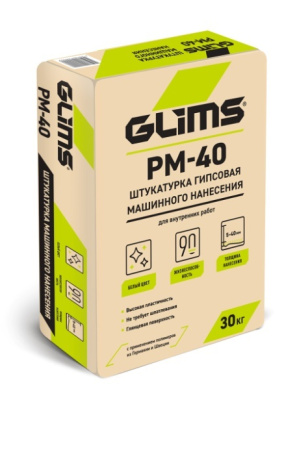The plaster is applied to lower stratum made of autoclaved lightweight concrete and porous concrete, Ytong blocks, to the brick walls made of clinker bricks, loam bricks and sand-lime bricks, to porous ceramic blocks, to slag blocks, LECA blocks, to site concrete, as well as to previously plastered surfaces. For mechanical application.
SURFACE PREPARATION
When applying and hardening the finishing mortar the temperature of the lower stratum and the environment should not be lower than +5 ° C. Before applying it is forbidden to cover the surface with drying oil, soap, etc. It is recommended to remove highly absorbent, dusty and loose layers from the surface. The surface of site concrete, brick walls made of ceramic bricks, concrete and slag blocks must be pre-treated with a ground coat GLIMS®БетоContact. The surface of brick walls made of silicate brick, autoclaved lightweight concrete, LECA or old plastered surfaces are recommended to be twice treated with a ground coat GLIMS®PrimeГрунт (“wet on wet”).
MORTAR PREPARATION
The water flow element at the plastering station must be set at a value of 500 - 600 l/h and the mortar consistency must be controlled depending on the applied layer thickness. At this the water consumption will be in the range of 0.41 - 0.43 l/kg of the dry mortar.
Material application
The finished mortar mix is applied evenly to the lower stratum with an overlapping of about 5 cm. The flow coming out of the nozzle perpendicular to the lower stratum should lie on the wall as a "herringbone".
Screeding. Within 10-15 minutes from the time of application the mortar applied to the lower stratum surface must be evenly leveled using the screed bar; joint displacement indicators are used if necessary. The screeding is carried out by the screed bar in vertical and horizontal directions, moving the material from areas with its surplus to areas where it is insufficient in thickness, filling in the recessions.
Float finish. To prepare the surface for painting after 60-90 minutes after screeding it is necessary to trowel the plaster with a sponge board abundantly wet with water. Then, after waiting for the gypsum slurry appearance on the surface, trowel the surface with a wide metal putty spattle or with a floater. Depending on the ambient humidity and temperature, as well as the thickness of the layer, the float finish time may vary. Additional recommendations. If it is necessary to achieve a perfectly smooth surface after applying the GLIMS®РМ-40 plaster, it is recommended to use GLIMS®Finish-LightRoom+ finish polymer filler or GLIMS®FinishГипс finish cement filler.
CONSUMPTION
0,9-1,0 kg/m2 with a layer thickness of 1 mm.
TRANSPORTATION AND STORAGE
During transportation and storage bags should be protected from damage and soaking. The storage period is 12 months. Dry plaster on a gypsum binder. Radiation safety class - 1. Specific activity of naturally occurring radionuclides is 40 ± 4.7 Bq/kg. TU5745-010-40397319-2003 №0370/2.
PRODUCT DISPOSAL
Dry mortar and hardened material must be disposed as building waste. It is forbidden to throw materials into the sanitary piping. The kraft paper bags should be disposed as household garbage.

